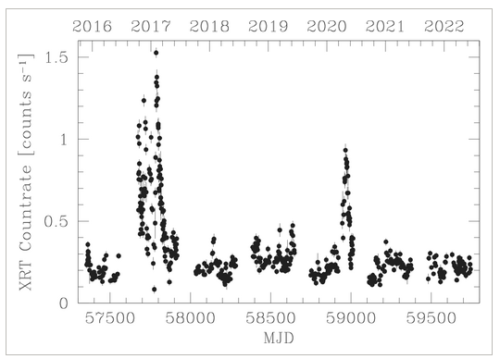- 大規模観測キャンペーンにより、活動銀河OJ 287の中心にある想定されるブラックホール連星について新たな知見が得られた
Large-scale observational campaign provides new insights into an assumed black hole binary at the centre of the active galaxy OJ 287
- 2022年10月に予測されたOJ 287の突発現象の不在と連星SMBHシナリオへの示唆 Absence of the predicted 2022 October outburst of OJ 287 and implications for binary SMBH scenarios
- MOMO VI. 2015年から2022年にかけてのブレイザーOJ 287の多周波電波変動、予測された2021年のペクサー・フレア活動の不在、2016/2017年のアウトバーストの新しい二項性解釈 MOMO. VI. Multifrequency Radio Variability of the Blazar OJ 287 from 2015 to 2022, Absence of Predicted 2021 Pecursor-flare Activity, and a New Binary Interpretation of the 2016/2017 Outburst
- ブレザーOJ 287の多波長天体物理学とプロジェクトMOMOの紹介 Multiwavelength astrophysics of the blazar OJ 287 and the project MOMO
大規模観測キャンペーンにより、活動銀河OJ 287の中心にある想定されるブラックホール連星について新たな知見が得られた Large-scale observational campaign provides new insights into an assumed black hole binary at the centre of the active galaxy OJ 287
2023-02-23 マックス・プランク研究所
◆ブレザーOJ 287は、高い活動性と極端な明るさを特徴とする、特殊な活動銀河の一種です。これらの銀河の原動力は、太陽の数百万倍から数十億倍も重いブラックホールが銀河の中心部に隠れていることです。宇宙の歴史の中で、これらのエンジンは、特に銀河が衝突したときに燃料を供給されました。その結果、超巨大連星ブラックホールが誕生した。このようなブラックホールのペアを研究することで、銀河の進化やブラックホールの成長について多くのことが明らかになる。
◆OJ287は、コンパクトな超巨大連星ブラックホールを持つ最有力候補の一つです。その証拠に、銀河の中心部で11年から12年おきに繰り返される例外的な放射線のバースト現象が見られます。このバーストは、厳密に言うと1年おきに2つのピークを形成しています。このように繰り返されるアウトバーストは非常に顕著であるため、これを説明するためにいくつかの異なる連星モデルが提案され、文献で議論されてきました。今回、マックスプランク電波天文研究所のシュテファニー・コモッサ氏が率いるチームは、これまでにない系統的な観測を行い、これまで有力視されていたモデルを修正しました。その過程で、研究者たちは初めて主ブラックホールの質量を直接決定しました。その結果、ブラックホールの質量は1億太陽質量と、これまで考えられていたよりも約100倍も小さいことがわかりました。また、このブラックホール質量の推定は、OJ287の放射線放出の全歴史を説明するものであり、その詳細な地図が完成したことになります。
<関連情報>
- https://www.mpg.de/19917498/0217-radi-oj287-blackholes-150300-x?c=2249
- https://academic.oup.com/mnrasl/advance-article/doi/10.1093/mnrasl/slad016/7044769?login=false
- https://iopscience.iop.org/article/10.3847/1538-4357/acaf71
- https://onlinelibrary.wiley.com/doi/10.1002/asna.20220126
2022年10月に予測されたOJ 287の突発現象の不在と連星SMBHシナリオへの示唆 Absence of the predicted 2022 October outburst of OJ 287 and implications for binary SMBH scenarios
S Komossa, D Grupe, A Kraus, M A Gurwell, Z Haiman, F K Liu, A Tchekhovskoy, L C Gallo, M Berton, R Blandford,J L Gómez, A G Gonzalez
Monthly Notices of the Royal Astronomical Society Letters Published:23 February 2023
DOI:https://doi.org/10.1093/mnrasl/slad016
Abstract
The project MOMO (Multiwavelength Observations and Modelling of OJ 287) was set up to test predictions of binary supermassive black hole (SMBH) scenarios and to understand disk-jet physics of the blazar OJ 287. After a correction, the precessing binary (PB) SMBH model predicted the next main outburst of OJ 287 in 2022 October, making the outburst well observable and the model testable. We have densely covered this period in our ongoing multi-frequency radio, optical, UV, and X-ray monitoring. The predicted outburst was not detected. Instead, OJ 287 was at low optical–UV emission levels, declining further into November. The predicted thermal bremsstrahlung spectrum was not observed either, at any epoch. Further, applying scaling relations, we estimate a SMBH mass of OJ 287 of 108 M⊙. The latest in a sequence of deep low-states that recur every 1–2 yrs is used to determine an upper limit on the Eddington ratio and on the accretion-disk luminosity. This limit is at least a factor of 10 lower than required by the PB model with its massive primary SMBH of >1010M⊙. All these results favor alternative binary SMBH models of OJ 287 that neither require strong orbital precession nor a very large mass of the primary SMBH.
MOMO VI. 2015年から2022年にかけてのブレイザーOJ 287の多周波電波変動、予測された2021年のペクサー・フレア活動の不在、2016/2017年のアウトバーストの新しい二項性解釈 MOMO. VI. Multifrequency Radio Variability of the Blazar OJ 287 from 2015 to 2022, Absence of Predicted 2021 Pecursor-flare Activity, and a New Binary Interpretation of the 2016/2017 Outburst
S. Komossa, A. Kraus, D. Grupe, A. G. Gonzalez, M. A. Gurwell, L. C. Gallo, F. K. Liu, I. Myserlis, T. P. Krichbaum, S. Laine
The Astrophysical Journal Published 2023 February 23
DOI:10.3847/1538-4357/acaf71

Abstract
Based on our dedicated Swift monitoring program, MOMO, OJ 287 is one of the best-monitored blazars in the X-ray–UV–optical regime. Here, we report results from our accompanying, dense, multifrequency (1.4–44 GHz) radio monitoring of OJ 287 between 2015 and 2022 covering a broad range of activity states. Fermi γ-ray observations were added. We characterize the radio flux and spectral variability in detail, including discrete correlation function and other variability analyses, and discuss its connection with the multiwavelength emission. Deep fades of the radio and optical–UV fluxes are found to occur every 1–2 yr. Further, it is shown that a precursor flare of thermal bremsstrahlung predicted by one of the binary supermassive black hole (SMBH) models of OJ 287 was absent. We then focus on the nature of the extraordinary, nonthermal, 2016/2017 outburst that we initially discovered with Swift. We interpret it as the latest of the famous optical double-peaked outbursts of OJ 287, favoring binary scenarios that do not require a highly precessing secondary SMBH.
ブレザーOJ 287の多波長天体物理学とプロジェクトMOMOの紹介 Multiwavelength astrophysics of the blazar OJ 287 and the project MOMO
S. Komossa, A. Kraus, D. Grupe, M.L. Parker, A. Gonzalez, L.C. Gallo, M.A. Gurwell, S. Laine, S. Yao, S. Chandra, L. Dey, J.L. Gómez, K. Hada, D. Haggard, A.R. Hollett, H. Jermak, S. Jorstad, T.P. Krichbaum, S. Markoff, C. McCall, J. Neilsen, M. Nowak
Astronomische Nachrichten Published: 25 January 2023
DOI:https://doi.org/10.1002/asna.20220126

Abstract
We are carrying out the densest and longest multiyear, multiwavelength monitoring project of OJ 287 ever done. The project MOMO (Multiwavelength Observations and Modeling of OJ 287) covers wavelengths from the radio to the high-energy regime. A few selected observations are simultaneous with those of the Event Horizon Telescope (EHT). MOMO aims at understanding disk-jet physics and at testing predictions of the binary black hole scenario of OJ 287. Here, we present a discussion of extreme outburst and minima states in context, and then focus on the recent flux and spectral evolution between 2021 and May 2022, including an ongoing bright radio flare. Further, we show that there is no evidence for precursor flare activity in our optical–UV–X-ray light curves that would be associated with any secondary supermassive black hole (SMBH) disk impact and that was predicted to start as thermal flare on December 23, 2021.



